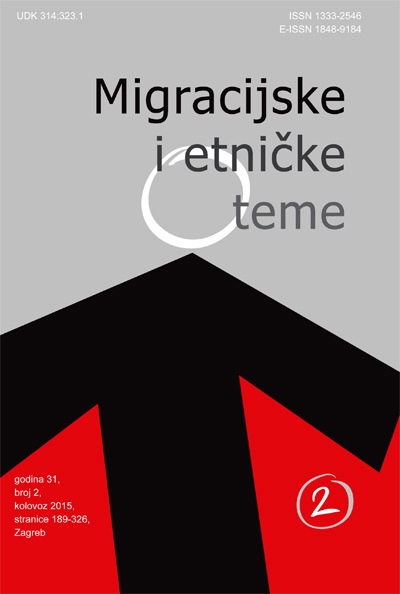Promjene u sastavu stanovništva prema narodnosti u Karlovačkoj i Ličko-senjskoj županiji od 1991. do 2011
Changes in the Ethnic Structure of the Population of Karlovac and Lika-Senj Counties in the period from 1991 to 2011
Author(s): Ivo Turk, Nikola Šimunić, Marta JovanićSubject(s): Social Sciences, Sociology, Demography and human biology, Migration Studies, Ethnic Minorities Studies
Published by: Institut za migracije i narodnosti
Keywords: ethnic structure; migration; depopulation; Croatian War of Independence; Karlovac County; Lika-Senj County
Summary/Abstract: In this article the authors deal with the changes in the ethnic structure of Karlovac and Lika-Senj counties in the period from 1991 to 2011 and analyse the factors influencing these changes. Special attention is given to the two most represented ethnic groups in Croatia – the Croats and the Serbs. Analysing the census data the authors emphasize that the most significant changes have been registered in the first analysed inter-census period from 1991 to 2001 what is ascribed to emigration, the Croatian War of Independence, population ageing and changes in the population census methodology. According to the population census from 1991 both counties recorded the majority of residents of Croatian ethnicity, while the population of Serbian ethnic group represented the most numerous national minority counting significant proportion of 25.4% in Karlovac and 36.4% in Lika-Senj County. The 2001 population census recorded national homogenization in the ethnic structure of both counties determined by the domination of Croats (counting around 85% in both counties). The data gathered by the most recent 2011 population census have not brought any significant changes in relation to the previous ones in Karlovac County, while in some parts of Lika-Senj County they registered a significant change associated with the return of the Croatian citizens of Serbian ethnicity. The studied issue was considered in the context of highly unfavourable general demographic situation characterised by significantly pronounced processes of population ageing and depopulation as well as by adverse economic conditions in the two analysed counties.
Journal: Migracijske i etničke teme
- Issue Year: 31/2015
- Issue No: 2
- Page Range: 275-309
- Page Count: 35
- Language: Croatian

